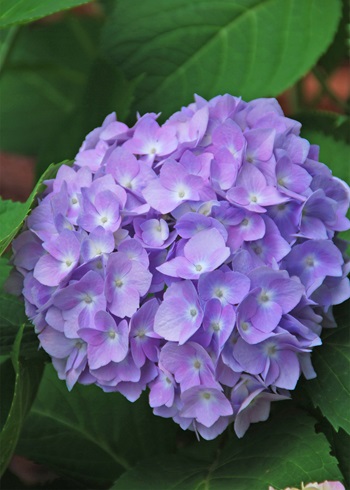
Low maintenance, beautiful flowers, and plenty of varieties have made hydrangeas a favorite landscape plant. It seems you can’t visit a garden center or nursery without being tempted by one of the traditional favorites or newer hydrangea varieties.
Despite their easy-care nature, hungry deer can make it difficult to fully enjoy these plants. Rutgers University rates landscape plants based on their susceptibility to deer damage. According to Rutgers, hydrangeas are occasionally severely damaged by deer, meaning they are a plant preferred by deer and protection is advised. Your experience may be different and can vary from year to year, but it is always wise to be prepared to protect key plants in your landscape.
Deer like to browse leaves, tender shoots, flower buds, and blossoms. Damage is worse when populations are high, food is scarce, and when environmental stresses like cold and deep snow are present. Once deer find a place to dine, they tend to return. Their damage has a rough or torn appearance as opposed to a clean cut like that made by a pruner. Preventing damage is always the best way to maximize your enjoyment. Even if your plants have escaped damage in the past, continue to watch for deer tracks, droppings, and plant damage.
Fencing is one option but not always the most attractive or practical. An eight-foot fence is the recommended height for protecting large areas. The University of Minnesota found deer can be kept out of small gardens that are 8 x 16 feet or smaller with much shorter fences. Sturdy decorative posts and somewhat invisible deer fencing tend to make a less obtrusive fence. Always check with your local municipality for any fencing restrictions.
Many gardeners report success using high-test fishing line. Create a barrier using strong five-foot posts with the fishing line spaced at two-foot intervals.
Scare tactics may provide some short-term help. Motion-sensitive sprinklers, noise makers, and smells are often used. Several gardeners have reported success placing colorful wine bottles inverted over rebar posts. The rattling helped discourage deer browsing and added an ornamental element to the garden. Occasionally change scare tactics to increase success.
Place key plants closer to your home, in the back of large beds, or surrounded by less susceptible plants. Making it hard to reach the plants can help discourage damage to hydrangeas.
Repellents are another option. Treat susceptible plants before the deer start browsing for the best results. Look for a rain and snow-resistant product, which does not need to be reapplied as often. That means you’ll save time applying and spend less money.
Maximize results by treating new growth according to the label directions. Most liquid repellents need time to dry and can only be applied when temperatures are above freezing. Always check the label for the product being applied and follow the directions for the best results.
Continue to monitor the landscape for signs of deer presence and damage and adjust your management strategies as needed. Be persistent so you can increase your success.
Melinda Myers has written more than 20 gardening books, including Small Space Gardening. She hosts the “How to Grow Anything” DVD series and the Melinda’s Garden Moment TV & radio segments. Her website is MelindaMyers.com.






Comment here